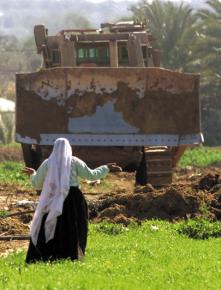Taking a side in Palestine
The conflict between Israel and the Palestinians is not between two evenly matched sides, but between oppressor and oppressed, explains .
ONCE AGAIN, Israel is unleashing hell on Gaza, moving beyond its everyday violence of occupation--with its control of Palestinian land; its imprisonment and torture of Palestinian youth and adults; its walls, checkpoints, surveillance, etc., etc.--to the even more brazen violence of bombing and invasion.
And once again, it is clarifying the minds of onlookers.
In the U.S., we're taught to see Israeli occupation and Palestinian resistance as a "cycle of violence," at which we must throw up our hands and say "it's too complicated" to understand or choose a side. But when Israel launches attacks like "Operation Pillar of Cloud," it makes the situation much less "complicated."
Anyone taking an honest look at Israeli F-16s bombing a trapped and largely defenseless Gaza has to question the U.S.-Israeli line--one that President Barack Obama, among other people, is "fully supportive of"--that Israel is simply "defending itself" from Palestinians.
But many progressives hesitate to place themselves decidedly on the side of the Palestinians, concluding instead that "violence on both sides" is to blame for the conflict.

Part of the reluctance to blame the nightmare unfolding in Palestine squarely on Israel is a desire to view the situation objectively. Objectivity--seeing things for what they are, as unbiased by beliefs and ideology as possible--is a fine starting point for understanding the situation. But if you look at the past week of violence in Palestine objectively, what emerges is a one-sided slaughter.
The most obvious indications of this are the numbers of Israelis and Palestinians who have been killed since Israel's "operation" began. As this article was being written, three Israelis had been killed by rockets fired from Gaza--and 118 Palestinians have been killed through Israeli violence. This number includes one Palestinian in the West Bank who was killed by Israeli occupation forces as he protested the Israel Defense Forces' assault on Gaza.
The wildly lopsided death toll is reason enough to doubt that this is a "conflict" between "two sides." But it is really just the starkest indication of a deeper reality. That reality is the power relationship between Israel and the Palestinians.
One side, Israel, has established a state on land stolen from the Palestinians, which it controls and "defends" by force. Everything the Palestinian struggle does is in response to this situation, which can only be called colonial.
Israel has the economic, military and diplomatic backing of the most powerful country in the world, the United States. Having systematically disarmed Gaza through siege and blockade, Israel is attacking a captive, civilian population. As Chris Hedges wrote years ago:
Israel uses sophisticated attack jets and Naval vessels to bomb densely crowded refugee camps, schools, apartment blocks, mosques and slums, to attack a population that has no air force, no air defense, no navy, no heavy weapons, no artillery units, no mechanized armor, no command and control, no army and calls it a war.
Those words unfortunately ring truer today--after six years of blockade and siege--than when they were written.
A LOOK at the daily functioning of Israel's occupation of Palestine further reveals the power dynamic.
There is, first of all, an Israeli occupation of Palestinian land. There is no Palestinian occupation of Israel. There are no Palestinian occupation forces. Israel is constructing a wall across Palestinian land, but there is no Palestinian wall across Israel.
As of September 2011, there were 522 Israeli checkpoints and roadblocks throughout the West Bank. There is not a single Palestinian checkpoint in Israel controlling the movement of its citizens.
These are not "two sides" in an equal "conflict"--one side is an oppressor and the other is the oppressed. Attempting to have an "even-handed" approach to both sides distorts the reality, which is not an even-handed one.
There are people who sympathize with Palestinians, but recoil in response to the rockets fired from Gaza at Israel. The case for supporting the right of the oppressed to resist oppression is the subject of other, excellent articles on this website. But for the purpose of answering the question of sides, this is the point: solidarity with the oppressed shouldn't be conditional on whether their resistance is in line with our beliefs or ideals.
No genuine anti-racist would question their opposition to racism because they disagree with how some Black person somewhere responds to racism. The same is true about opposition to sexism. Yet this basic solidarity with the struggle against oppression and violence is too often denied to Palestinians and other peoples whose oppression is supported and enabled by the U.S. government.
This is a last and important point. Those of us in the U.S. need to keep in mind that the outlook of American politicians and the coverage of the mainstream media are decidedly biased. The 1 percent of the U.S. is behind Israel 100 percent because this alliance secures their interests in the Middle East. And the 1 percent controls the media.
When the New York Times editorializes that Hamas began the current war by firing rockets at Israel and that this "will never get Palestinians the independent state most yearn for, but it is all Hamas has to offer," it is not out of concern for justice or the Palestinians. The Times is concerned about making sure that the U.S. and Israel preside over a Middle East where American interests are "safe." Moreover, the U.S. government and media teach us to always side with powerful, usually pro-U.S. forces against oppressed peoples.
Taking on that establishment and the ideas it promotes is a formidable task. But it starts with choosing the side of the oppressed in an assault launched by the oppressor. Take the side of Palestine.


